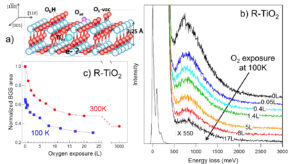On the controversial origin of the band gap states of titanium dioxide

Currently used in self-cleaning windows and dye-sensitized solar cells, titanium dioxide TiO2 is a promising material for the photochemical purification of air and water or for hydrogen production via water splitting. Its particular photocatalytic properties are intimately related to the so-called excess electrons that stem from either photon absorption or sub-stoichiome-tric defects. In a seemingly antithetical way that rely on the polaronic distortion they induce, excess electrons contribute both to the conductivity of the material and to a deep band gap state seen in photoemission. In the case of the sub-stoichiometric (reduced) form TiO2-x, the behaviour of the material is clearly governed concomitantly by the oxygen vacancies and titanium interstitials. However, the actual contribution of titanium interstitials to the gap state is hotly debated. To deal with this central issue, researchers of the “Low dimensional oxidesLow-dimensional oxides” group from INSP have used the high-resolution electron-loss spectroscopy, a tech- nique which became very rare…
Références
« Contributions of oxygen vacancies and titanium interstitials to band-gap states of reduced rutile », Jingfeng Li, Rémi Lazzari, Stéphane Chenot, Jacques Jupille, Phys. Rev. B Rapid Comm., 97, 041403(R) (2018)
« Origin, location and transport of excess charges in titanium dioxide », Jingfeng Li, PhD thesis University Pierre and Marie Curie (2016)
« Spectral restoration in reflection energy electron loss spectroscopy based on iterative semi-blind Lucy-Richardson algorithm applied to rutile surfaces », Rémi Lazzari, Jingfeng Li, Jacques Jupille, Rev. Sci. Instrum., 86, 013906 (2015)

